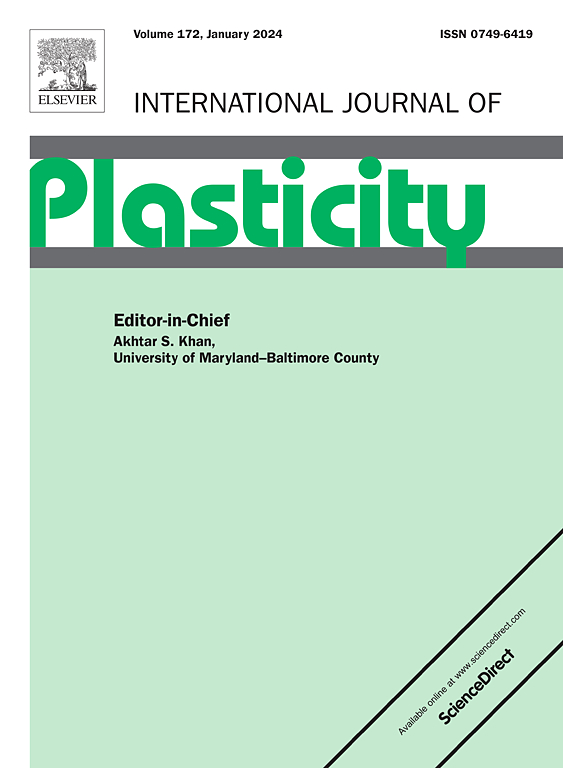Tensile plasticity in amorphous microwires: The role of ion irradiation-induced gradient rejuvenation
IF 12.8
1区 材料科学
Q1 ENGINEERING, MECHANICAL
引用次数: 0
Abstract
Amorphous alloys possess exceptional mechanical properties such as high strength and elasticity but suffer from limited tensile plasticity at room temperature, categorizing them as quasi-brittle materials. Ion irradiation has emerged as a promising method for improving their plasticity by inducing gradient rejuvenation structures that modify the distribution of free volume. In this study, H⁺ irradiation was applied to amorphous microwires (AMs), introducing a nonlinear gradient rejuvenation structure with thickness of ∼1.76 μm, which features a free volume distribution that first increases to a certain depth and then decreases from the surface to the interior. It not only effectively hinders the propagation of the dominant shear band (SB) at the interface between high and low free volume regions but also promotes the formation and branching of numerous fine SBs within the rejuvenated region. The combination of these two effects results in significant enhancement of the tensile plasticity to ∼ 2.97 % while maintaining high yield strength (1680 MPa) of AMs. This outcome provides insights into the mechanisms enabling improved plasticity and highlights the potential of nonlinear gradient rejuvenation as a strategy to optimize the mechanical properties of bulk amorphous alloys, offering a promising pathway for developing next-generation high-performance metallic materials.


非晶微丝的拉伸塑性:离子辐照诱导梯度返老还老的作用
非晶合金具有优异的力学性能,如高强度和弹性,但在室温下拉伸塑性有限,属于准脆性材料。离子辐照已成为一种很有前途的方法,通过诱导改变自由体积分布的梯度返老还老结构来改善它们的可塑性。在本研究中,H +辐照应用于非晶微线(AMs),引入了厚度为~ 1.76 μm的非线性梯度回传结构,其自由体积分布先增加到一定深度,然后从表面到内部减小。它不仅有效地阻碍了高、低自由体积区界面处优势剪切带(SB)的传播,而且促进了再生区内大量细小剪切带的形成和分支。这两种作用的结合使AMs的拉伸塑性显著提高到约2.97%,同时保持较高的屈服强度(1680 MPa)。这一结果为提高塑性的机制提供了深入的见解,并突出了非线性梯度再生作为优化大块非晶合金力学性能的策略的潜力,为开发下一代高性能金属材料提供了一条有希望的途径。
本文章由计算机程序翻译,如有差异,请以英文原文为准。
求助全文
约1分钟内获得全文
求助全文
来源期刊

International Journal of Plasticity
工程技术-材料科学:综合
CiteScore
15.30
自引率
26.50%
发文量
256
审稿时长
46 days
期刊介绍:
International Journal of Plasticity aims to present original research encompassing all facets of plastic deformation, damage, and fracture behavior in both isotropic and anisotropic solids. This includes exploring the thermodynamics of plasticity and fracture, continuum theory, and macroscopic as well as microscopic phenomena.
Topics of interest span the plastic behavior of single crystals and polycrystalline metals, ceramics, rocks, soils, composites, nanocrystalline and microelectronics materials, shape memory alloys, ferroelectric ceramics, thin films, and polymers. Additionally, the journal covers plasticity aspects of failure and fracture mechanics. Contributions involving significant experimental, numerical, or theoretical advancements that enhance the understanding of the plastic behavior of solids are particularly valued. Papers addressing the modeling of finite nonlinear elastic deformation, bearing similarities to the modeling of plastic deformation, are also welcomed.
 求助内容:
求助内容: 应助结果提醒方式:
应助结果提醒方式:


